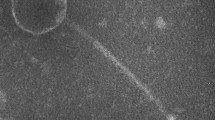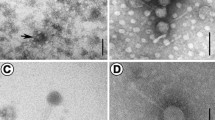Abstract
Phage H188, a novel Vibrio kanaloae phage, was isolated from the surface water of Yellow Sea. Morphological analysis by transmission electron microscopy reveals that it belongs to the family Myoviridae. Present result suggests that the phage is stable at pH between 4.0 and 12.0. No significant difference in phage titers is noted at temperature 30-50 °C. A latent period of approximately 96 mins is indicated by the one-step growth curve. And, the burst size is about three virions per cell. Furthermore, genomic analysis of H188 reveals a genome size of 50364 bp with 43.63 % G+C content, and 76 putative open reading frames. There is no obvious similarity between H188 and other known phages by genomic comparison. Moreover, the H188 genome includes modules for phage structure, phage packaging, DNA replication and regulation, and some additional functions.






Similar content being viewed by others
References
Casjens SR (2005) Comparative genomics and evolution of the tailed-bacteriophages. Curr Opin Microbiol 8:451–458. doi:10.1016/j.mib.2005.06.014
Duda RL, Martincic K, Hendrix RW (1995) Genetic Basis of Bacteriophage HK97 Prohead Assembly. J Mol Biol 247:636–647. doi:10.1006/jmbi.1994.0169
Grimes DJ, Johnson CN, Dillon KS, Flowers AR, Noriea NF 3rd, Berutti T (2009) What genomic sequence information has rvealed about vibrio ecology in the ocean-a review. Microb Ecol 58:447–460. doi:10.1007/s00248-009-9578-9
Karunasagar I, Shivu MM, Girisha SK, Krohne G, Karunasagar I (2007) Biocontrol of pathogens in shrimp hatcheries using bacteriophages. Aquaculture 268:288–292
Lipps G, Weinzierl AO, von Scheven G, Buchen C, Cramer P (2004) Structure of a bifunctional DNA primase-polymerase. Nat Struct Mol Biol 11:157–162. doi:10.1038/nsmb723
Middelboe M, Chan AM, Bertelsen SK (2010) Isolation and life cycle characterization of lytic viruses infecting heterotrophic bacteria and cyanobacteria. In: Wilhelm SW, Weinbauer MG, Suttle CA (eds) Manual of aquatic viral ecology. ASLO, US, pp 118–133
Monk AB, Rees CD, Barrow P, Hagens S, Harper DR (2010) Bacteriophage applications: where are we now? Lett Appl Microbiol 51:363–369. doi:10.1111/j.1472-765X.2010.02916.x
Moodley S, Maxwell KL, Kanelis V (2012) The protein gp74 from the bacteriophage HK97 functions as a HNH endonuclease. Protein Sci 21:809–818. doi:10.1002/pro.2064
Němeček D, Lander GC, Johnson JE, Casjens SR, Thomas GJ (2008) Assembly architecture and DNA binding of the bacteriophage P22 terminase small subunit. J Mol Biol 383:494–501. doi:10.1016/j.jmb.2008.08.050
Paul JH, Sullivan MB, Segall AM, Rohwer F (2002) Marine phage genomics. Comp Biochem Phys B 133:463–476. doi:10.1016/S1096-4959(02)00168-9
Pickard D, Thomson NR, Baker S, Wain J, Pardo M, Goulding D, Hamlin N, Choudhary J, Threfall J, Dougan G (2008) Molecular characterization of the Salmonella enterica serovar Typhi Vi-typing bacteriophage E1. J Bacteriol 190:2580–2587. doi:10.1128/JB.01654-07
Stabili L, Giangrande A, Pizzolante G, Caruso G, Alifano P (2014) Characterization of vibrios diversity in the mucus of the polychaete Myxicola infundibulum (Annellida, Polichaeta). Microb Ecol 67:186–194. doi:10.1007/s00248-013-0312-2
Thompson FL (2003) Vibrio kanaloae sp. nov., Vibrio pomeroyi sp. nov. and Vibrio chagasii sp. nov., from sea water and marine animals. Int J Syst Evol Micr 53:753–759. doi:10.1099/ijs.0.02490-0
Ul Haq I, Chaudhry WN, Andleeb S, Qadri I (2012) Isolation and partial characterization of a virulent bacteriophage IHQ1 specific for Aeromonas punctata from stream water. Microb Ecol 63:954–963. doi:10.1007/s00248-011-9944-2
Verheust CJG, Mahillon J (2003) pGIL01, a linear tectiviral plasmid prophage originating from B. Thuringiensis serovar israelensis. BMC Microbiol 149:2083–2092. doi:10.1099/mic.0.26307-0
Victor S, I-Wei F, Forest R et al (2003) Genome sequences of two closely related Vibrio parahaemolyticus phages, VP16T and VP16C. J Bacteriol 185(21):6434–6447. doi:10.1128/JB.185.21.6434-6447.2003
Wood WB, Conley MP, Lyle HL, Dickson RC (1978) Attachment of tail fibers in bacteriophage T4 assembly. J Biol Chem 253:2437–2445. doi:10.1016/0022-2836(79)90455-8
Ye J, Osborne AR, Groll M, Rapoport TA (2004) RecA-like motor ATPases–lessons from structures. BBA-Bioenergetics 1659:1–18. doi:10.1016/j.bbabio.2004.06.003
Acknowledgments
This work was supported by the National Natural Science Foundation of China (NSFC) (Nos. 41076088, 31500339), the National Key Basic Research Program of China (973 Program) (No. 2013CB429704), the China Postdoctoral Science Foundation (No. 2015M570612), and the Chinese Polar Environment comprehensive Investigation & Assessment Programs (No. CHINARE-01-05).
Author information
Authors and Affiliations
Corresponding authors
Rights and permissions
About this article
Cite this article
Li, Y., Wang, M., Liu, Q. et al. Complete Genomic Sequence of Bacteriophage H188: A Novel Vibrio kanaloae Phage Isolated from Yellow Sea. Curr Microbiol 72, 628–633 (2016). https://doi.org/10.1007/s00284-015-0984-6
Received:
Accepted:
Published:
Issue Date:
DOI: https://doi.org/10.1007/s00284-015-0984-6




